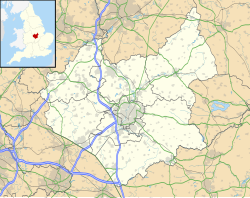Greyfriars, Leicester

Greyfriars site superimposed on a modern map of the area. Richard III's burial site is shown by a small dot.
|
|
| Monastery information | |
|---|---|
| Other names | Leicester Franciscan Friary |
| Order | Order of Friars Minor |
| Established | Before 1230 |
| Disestablished | 1538 |
| Dedicated to | Unclear: Possibly St. Francis of Assisi or St. Mary Magdalene |
| Diocese | Lincoln |
| People | |
| Founder(s) |
Unclear Traditionally credited but unlikely: Simon de Montfort, 6th Earl of Leicester Suggested either: Gilbert and Ellen Luenor, or John Pickering |
| Site | |
| Location | Leicester |
| Coordinates | 52°38′02″N 1°08′11″W / 52.634007°N 1.136431°WCoordinates: 52°38′02″N 1°08′11″W / 52.634007°N 1.136431°W |
| Grid reference | SK58650434 |
| Visible remains | None |
Greyfriars, Leicester, was a friary of the Friars Minor, commonly known as the Franciscans, established on the west side of Leicester by 1250, and dissolved in 1538. Following dissolution the friary was demolished and the site levelled, subdivided, and developed over the following centuries. The locality has retained the name Greyfriars particularly in the streets named "Grey Friars", and the older "Friar Lane".
The friary is best known as the burial place of King Richard III who was hastily buried in the friary church following his death at the Battle of Bosworth. An archaeological dig in 2012/13 successfully identified the site of the Greyfriars church and the location of Richard's burial. The grave site was incorporated into the 'Dynasty, Death and Discovery' museum which opened in 2014.
Mendicant friars of the Order of Friars Minor, also known as Franciscans, and as the "grey friars" due to the colour of their religious habit, first arrived in Britain in 1224, two years before St Francis died. Nine friars came over from France to Canterbury, and rapidly attracted new members to the order. By the spring of 1225 they also had houses in London and Oxford (initially just borrowed rooms befitting an order vowed to poverty and simplicity). Expansion to Cambridge, Northampton and Norwich followed, continuing the pattern of modest premises in the midst of populous towns. Friars arrived at Leicester as part of this first wave of expansion, some time before 1230, and by 1237 Leicester was sufficiently established to be one of seven English friaries that had lectors, with responsibility for teaching new recruits to the order. By 1240 there were 29 English Franciscan houses, and by 1255 there were 1,242 friars in 49 houses.
The process by which the Leicester friars acquired their large plot of ground within the town is unclear, but is thought to be a mid-13th century foundation.Simon de Montfort, 6th Earl of Leicester, has traditionally been credited with playing a part in this, having become Earl in 1231. Stow suggested Gilbert and Ellen Luenor were the actual founders, whilst antiquarian Francis Peck has suggested that John Pickering was either the founder or a very early benefactor of the friary. The excavations of 2013 opened a stone coffin, buried in front of the high altar of the church. Preliminary analysis suggests the occupant was a woman, and almost certainly a major benefactor, although her identity is as yet unknown.
...
Wikipedia

